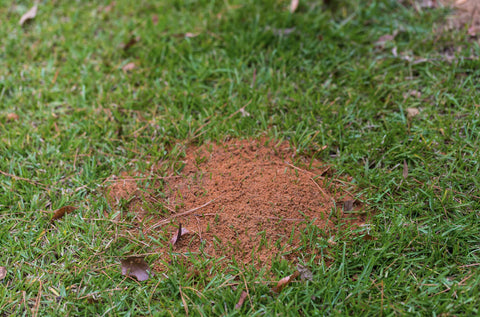What exactly are worm casts, and how can you eliminate them?
While worms are a sign of healthy soil and active soil biology, the casts they deposit on lawns can detract from its appearance.
Worm casts can vary in size and appearance and are most commonly found on moist lawns, particularly after periods of rain or in areas with high earthworm activity.
Excessive worm casting can create uneven surfaces on the lawn and may even smother the grass, leading to patches of dead or damaged turf.
If you're dealing with worm casts on your lawn, there are a few steps you can take to manage them:
- Remove them: While it may be a bit tedious, manually removing worm casts from your lawn can help prevent them from smothering the grass and creating uneven surfaces.
- Brush them in: Use a stiff brush to brush the worm casts into the grass. This helps distribute the soil and organic matter more evenly across the lawn, minimising the impact on its appearance.
- Reduce worm activity: While worms are beneficial for soil health, excessive worm activity can lead to an abundance of worm casts on the lawn. You can try to reduce worm activity by improving drainage in waterlogged areas, reducing thatch build-up through scarification (link), and avoiding overwatering.
- Aerate the lawn: Aerating (link) your lawn can help improve drainage and reduce waterlogging, which may discourage worms from surfacing to deposit their casts.
Ants on your lawn?

Are ants in the lawn bad? Ants are not generally considered dangerous to the lawn, they can be a sign of a healthy ecosystem, which we are all for. They can actually help de-compact and aerate the soil. They are quite fascinating creatures with how they work. They live in nests that contain hundreds or even thousands of ants, with one ‘queen’ ant and many ‘worker’ ants. The workers are responsible for foraging for food, as well as caring for the queen.
However, ants can be a nuisance, and an ant infestation can quickly become a problem both in the garden and inside your home. While the common garden ant doesn’t bite, red and flying ants can sting, which can be unpleasant. Additionally, ants produce formic acid, which can negatively affect both lawns and humans. During summer, when we spend the most time outdoors, ants are particularly unwelcome. They often enter homes in search of food, and the last thing we want is ants crawling on us while we’re trying to relax, eat, or play in the garden.
When large colonies of ants set up home in your lawn, they create ant hills, which for us lawn lovers can be very unsightly. The mounds of earth ruin the look of a lawn, make the surface uneven and unwanted side effects from mowing, e.g., scalping the lawn. Also, ants can potentially create areas of bare soil for weeds to populate.
How to get rid of ant hills without killing grass?
There is no approved insecticide in the professional market for the control of ants. There are, however, several products of powder etc in the garden market, which can prove useful.
The following is a process which has been used successfully to manage ants in your lawn…
- Find the nest, usually found as a hill or just soil thrown up on to the surface.
- Take a spade and slice into the nest, try, and go down to approx. 20-25cms (8-10 inches).
- Move the spade backwards and forwards to make a crevice.
- Using a good brand of ant powder from your local garden centre, pour the powder down into the middle of the nest.
- Remove the spade, ensuring you shake off as much powder as you can into the nest.
- Push the crevice back together.
Over the next 7-10 days you should notice less activity and the grass turning back to normal.
It’s important you do not apply any ant powder to the surface of the lawn. This will have a negative impact on the grass.
How to deal with an ant hill
Firstly, you need to get rid of the ants by following the process outlined above.
Then, when there is no ant activity, it is good to remove the turf from the hill and break up the nest runs until you have levelled out the areas. Then return to the turf and place it back on the area you have been working on.
It’s worth noting that we do not recommend using boiling water on the ant’s nest. You will damage the lawn and leave it more vulnerable to weeds. Instead, as ants prefer dry conditions, you should regularly water your lawn. This will help your lawn survive throughout the dry weather but also encourage the ants to move on.
We recommend watering your lawn early in the morning or late in the evening to avoid evaporation.
You can read our tips on how to conserve water in your garden here: Tips for conserving water in your garden – GreenThumb
For further advice, you can speak to your local GreenThumb branch, and they’ll do their best to advise. You can find the details of your local branch here: Find your local GreenThumb branch

